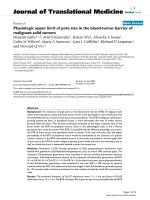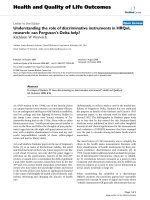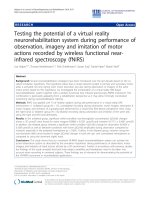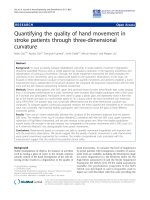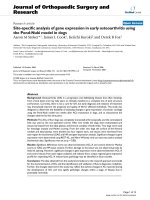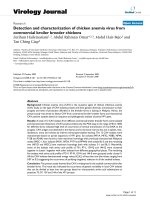Báo cáo hóa học: " Mechanisms underlying center of pressure displacements in obese subjects during quiet stance" pdf
Bạn đang xem bản rút gọn của tài liệu. Xem và tải ngay bản đầy đủ của tài liệu tại đây (309.26 KB, 6 trang )
RESEARCH Open Access
Mechanisms underlying center of pressure
displacements in obese subjects during
quiet stance
Francesco Menegoni
1
, Elena Tacchini
1
, Matteo Bigoni
2
, Luca Vismara
1
, Lorenzo Priano
2,3
, Manuela Galli
4,5
and
Paolo Capodaglio
1*
Abstract
Objective: the aim of this study was to assess whether reduced balance capacity in obese subjects is secondary to
altered sensory information.
Design: cross sectional study.
Subjects: 44 obese (BMI = 40.6 ± 4.6 kg/m
2
, age = 34.2 ± 10.8 years, body weight: 114,0 ± 16,0 Kg, body height
167,5 ± 9,8 cm) and 20 healthy controls (10 females, 10 males, BMI: 21.6 ± 2.2 kg/m
2
, age: 30.5 ± 5.5 years, body
weight: 62,9 ± 9,3 Kg, body height 170,1 ± 5,8 cm) were enrolled.
Measurements: center of pressure (CoP) displacements were evaluated during quiet stance on a force platform
with eyes open (EO) and closed (EC). The Romberg quotient (EC/EO) was computed and compared between
groups.
Results: we found statistically significant differences between obese and controls in CoP displacements (p < 0.01)
and no statistically significant differences in Romberg quotients (p > 0.08).
Conclusion: the increased CoP displacements in obese subjects do not need an hypothesis about altered sensory
information. The integration of different sensory inputs appears similar in controls and obese. In the latter, the
increased mass, ankle torque and muscle activity may probably account for the higher CoP displacements.
Keywords: balance obesity, center of pressure
Introduction
In the last decade obesity has been recognized as a
major world health problem characterized by an alarm-
ing growing rate and an i mportant risk factor for var-
ious pathologies [1]. There is also epidemiologi cal
evidence that suggests that obesity increases the risk of
falling [2] and complicates the treatment of the conse-
quences [3-5]. Quite a number of studies have investi-
gated the integrity of the postural control system in
obese, specifically focusing on s tatic posturography, by
analyzing the centre of pressure (CoP) [6-12]. A general
consensus emerges from the literature about an increase
in CoP displacements in obese subjects. However, the
physiological mechanisms underlying such generally
observed behavior still need to be unveiled. In fact, the
control of human stance depends on both the musculos-
keletal and the nervous systems. The latter is strictly
influenced by the integration of different sensory (i.e.:
visual, vestibular and proprioceptive) inputs [13]. To our
knowledge, this aspect (i.e.: the integration of different
sensory inputs involve d in the control of stance) has not
been yet investigated in obese subjects. In this popula-
tion, a condition that can lead to visua l and vestibular
alterations, known as “pseudotumor cerebri”,hasbeen
reported [14]. An altered contribution of sensory e nd-
ings and mechanoceptors has been recently proposed as
a possible cause of the differences in CoP displacements
between obese and healthy subjects [6]. Such hypothesis,
however, has not been experimentally demonstrated.
* Correspondence:
1
Orthopaedic Rehabilitation Unit and Clinical Lab for Gait and Posture
Analysis, Ospedale San Giuseppe, Istituto Auxologico Italiano, IRCCS,
Piancavallo, Verbania (VB), Italy
Full list of author information is available at the end of the article
Menegoni et al. Journal of NeuroEngineering and Rehabilitation 2011, 8:20
/>JNER
JOURNAL OF NEUROENGINEERING
AND REHABILITATION
© 2011 Menegoni et al; licensee BioMed Central Ltd. This is an Open Access article distributed under th e terms of the Creative
Commons Attribution License ( whic h permits unrestricted use, distribution, and
reproduction in any medium, provided the original work is properly cited.
Rather, it has been formulated on the basis of previous
findings about foot pressure distribution in obese indivi-
duals [10,15], and the role of mechanocepto rs and cuta-
neous sensation in balance control [16,17].
Some neurological studies [18-21] have investigated
the strategies of the central nervous system dealing with
var ious sensory impairments. It appears that the system
could adopt long-term plastic changes together with
short-term gain modulations between the sensory mod-
alities, depending on their availability and r eliability. As
a consequence, individuals with altered sensory inputs,
and expectedly with greater CoP displacemen ts, should
place lower demand on the altered ("negative gain”) and
great er demand on the unaffected sensory inputs ("posi-
tive gain”) to maintain postural stability. This mechan-
ism has been previously defined as the “reweight of
sensory inputs” [18].
Postural trials under eyes open (EO) and closed (EC)
conditions and the so-called Romberg quotient (i.e.: EC/
EO), extensively used in clinics, represent easy and non-
invasive testing modalities to indirectly discriminate pos-
sible sensory impairments. In healthy subjects, the EO
condition involves the integration of visual, vestibular
and proprioceptive information, while under EC condi-
tion the subject relies on vestibular and pro prioceptive
inputs to maintain balance. Thus, the presence of
altered sensory inputs yields different consequences on
CoP displacements ac cording to the EO or EC testing
condition. For example, impaired vision may have two
consequences: increased CoP displacements under EO
(the system relies mainly on proprioc eptive and vestibu-
lar information) and no changes under EC condition
(the system relies again on proprioceptive and vestibular
information). In such a case, the Romberg quotient
would approximate 1 (i. e.: same performance in EC and
EO), which is in line with the reports of two studies on
individuals with vision loss [22,23]. As for impaired pro-
prioception, two consequences are to be expected: possi-
ble increase of CoP displacements under EO (the system
relies mainly on visual and vestibular information) and
increased CoP displacements under EC condition (the
system relies mainly on vestibular information). In this
case, the Rombe rg quotient is expected to increase [24].
Similar consequences can be observed in individuals
with impaired vestibular input, but they are not always
detectable by the Romberg quotient [25,26].
Since sensory information is fundamental for balanc e
control, we decided to focus our investigation on these
aspects. Despite speculations had been made, to our
knowledge, no studies have so far experimentally inves-
tigated the mechanisms underlying poor postural stabi-
lity in obese subjects. Therefore the aim o f this study
was to assess whether the increased CoP displacements
in obese subjects are secondary to altered sensory
information.
Materials and methods
Subjects
Fourty-four obese subjects (Body Mass Index -BMI ≥ 30
kg/m2), 22 males and 22 females (BMI = 40.6 ± 4.6 kg/
m
2
, age = 34.2 ± 10.8 years; body weight: 114,0 ± 1 6,0
Kg, body height 167,5 ± 9,8 cm), previously enrolled for
another study [7], served as the obese group (O). All of
them were free from conditions possibly associated to
impaired balance: in particular, we decided to exclude
subjects with vision loss/alteration, vestibular impair-
ments, neuropathy, as detected by the clinical examina-
tion and those who reported symptoms related to
intracranial hypertension [14]. Their lean counterpart
consisted of 20 age-matched healthy subjects (H)
recruited among the hospital staff (10 females, 10 males,
BMI: 21.6 ± 2.2 kg/m
2
, age: 30.5 ± 5.5 years; body
weight: 62,9 ± 9,3 Kg, body height 170,1 ± 5,8 cm). Sub-
jects were naïve to the experimental protocol and proce-
dures before the two proposed trials. All subjects
included in th e study had no evidences or known his-
tory of a gait, postural, or skeletal disorder and no his-
tory of falls. They were all sedentary subjects. The study
wasapprovedbytheEthicCommitteeoftheIstituto
Auxologico Italiano and an informed consent was
obtained from each subject prior to participation.
Experimental setup
Subjects were asked to look ahead with head straight,
arms at the sides in a comfortable position and to stand
barefoot on the force platform (Kistler, CH, sampling
rate 100Hz), in a stand ard positio n with 30° feet abduc-
tion and heels at a distance of 8 cm. Two 60-second
acquisitions were recorded: one under EO and another
under EC condition [7].
No familiarization session before the trials was pro-
posed to the subjects. A 2-minute interval time was pro-
vided between different trials. Three 60-second
acquisitions under EO and 3 under EC condition were
recorded. The mean value of the three trials under each
conditions was calculated.
Postural Parameters
Data from force platform were processed to obtain pos-
tural parameters about the CoP displacements. Specifi-
cally we computed following parameters in the a ntero-
posterior (AP) and medio-lateral (ML) axes: Root Mean
Square (RMS) of CoP positions (RMS
AP
and RMS
ML
),
maximum excursion of CoP along the axes (RANGE
AP
and RANGE
ML
), and mean velocity of CoP displace-
ments along the axes (MV
AP
and MV
ML
) [7].
Menegoni et al. Journal of NeuroEngineering and Rehabilitation 2011, 8:20
/>Page 2 of 6
For the planar movement of the CoP, we analyzed the
RMS distance of the CoP series from the centre
(RMS
CoP
), the area of the ellipse covering the 85.35% of
CoP sway area (AREA
CoP
), as well as the mean CoP
velocity (MV
CoP
) [7].
According to Rocc hi et a l. [27] and Chiari et al. [28],
all parameters were normalized to the individual height
in order to avoid the potential misinterpretation of data
in between-groups comparisons. The Romberg index
(EC score/EO score) was computed for all the para-
meters considered.
Statistical analysis
Unless otherwise noted, all data are presented as mean
± one standard deviation, SD. Before using parametric
statistical procedures, the assumption of normality was
verified. Statistical analysis was performed using the Sta-
tistica software (StatSoft, U.S.). If the assumption of nor-
mality was verified, the parametric Student’st-testfor
independent groups was used to investigate differences
between obese and lean subjects (p < 0.05), otherwise
the non-parametric equivalent Mann-Whitney U-test
was applied.
Comparisons of CoP parameters between healthy (H)
and obese (O) groups under EO condition were per-
formed in order to confirm the greater CoP displace-
ments observed in obese individuals. Then we
performed comparisons of Romberg quotients between
O and H, and BMI-Romberg correlation by means of
Pearson r coefficient, in order to assess the impairment
of sensory inputs in obese subjects.
Results
One male subject of the healthy group showed a Rom-
berg value greater than 3.8 in 6 out of 9 parameters and
was considered an outlier and eliminated from subse-
quent analysis.
In H, the EO parameters followed a normal distribu-
tion, while in O only MV
CoP
and RMS
CoP
did not vio-
late the normality assumption. Results about differences
between H and O in terms of EO parameters confirmed
the grater displacements of CoP characterizing obese
individuals (Table 1).
In the H group, the Romberg quoti ent for weight and
MV
AP
violated the normality assumption. In the O
group, the Romberg quotient for RMS
CoP
,AREA
CoP
,
RMS
AP
,andRMS
ML
did not violate the normality
assumption.
We did not find any statistically significant difference
between obese subjects and healthy controls, in terms of
Romberg index of posture parameters (Table 2).
As for the correlation between BMI and the computed
Romberg quotients, despite statistical significance (p =
0.045), we found only a weak correlation (r = 0.253)
between BMI and RANGE
AP
(Figure 1). All other para-
meters did not show significant correlation (r = 0.233 -
0.008, p = 0.066 - 0.953).
Discussion
It is well known that the experimental conditions as well
as a set of biomechanical factors have influence on sta-
bilometric parameters: body height and weight, base of
support area, maximum foot width, and feet opening
ang le [28,29] . Since the core of this study was the com-
parison between non-homogenous groups in terms of
weight (H and O), we tried to minimize the influence of
all factors but weight, by using the same experimental
setup, experimental conditions, and by normalizing
parameters to height. Our data show that under EO
conditions obese individuals present higher CoP displa-
cements during quiet stance than their lean
counterparts.
CoP parameters can be classified as related to postural
activity for maintaining stability (i.e.: velocity of CoP) (6)
or related to effectiveness of the postural system ( i.e.:
magnitude of CoP displacements) [30]. In our study,
obese individuals were characterized by an increased
postural activity (Table 1, MV
AP
,MV
ML
,MV
CoP
). This
Table 1 Comparison of CoP parameters between healthy
(H) and obese (O) groups.
EO condition H (n = 19) O (n = 44)
RMS
AP
[mm] 3.0 ± 0.9 3.9 ± 1.0 § p = 0.002
RANGE
AP
[mm] 16.7 ± 4.9 21.8 ± 6.0 § p = 0.004
MV
AP
[mm/s] 6.5 ± 2.0 9.7 ± 1.5 § p < 0.001
RMS
ML
[mm] 2.4 ± 0.6 3.1 ± 1.0 § p = 0.008
RANGE
ML
[mm] 13.6 ± 3.9 17.8 ± 5.6 § p = 0.005
MV
ML
[mm/s] 5.4 ± 1.6 6.9 ± 1.6 § p = 0.001
RMS
CoP
[mm] 3.8 ± 1.1 5.0 ± 1.2 † p < 0.001
AREA
CoP
[mm
2
] 88.4 ± 42.5 143.7 ± 73.8 § p = 0.005
MV
CoP
[mm/s] 9.4 ± 2.7 13.2 ± 2.1 † p < 0.001
§ Mann-Whitney U test; † Student’s t-test. AP: anterior-posterior; ML: medio-
lateral
Table 2 Comparison of Romberg quotient of CoP
parameters between healthy (H) and obese (O) groups.
Romberg quotient H (n = 19) O (n = 44)
RMS
AP
1.05 ± 0.23 1.18 ± 0.27 † p = 0.087
RANGE
AP
1.07 ± 0.20 1.24 ± 0.37 § p = 0.168
MV
AP
1.17 ± 0.18 1.26 ± 0.22 § p = 0.151
RMS
ML
1.05 ± 0.20 1.06 ± 0.17 † p = 0.849
RANGE
ML
1.14 ± 0.23 1.06 ± 0.26 § p = 0.112
MV
ML
1.13 ± 0.18 1.11 ± 0.18 § p = 0.811
RMS
CoP
1.05 ± 0.18 1.12 ± 0.20 † p = 0.141
AREA
CoP
1.12 ± 0.38 1.27 ± 0.38 † p = 0.151
MV
CoP
1.15 ± 0.17 1.20 ± 0.19 § p = 0.323
§ Mann-Whitney U test; † Student’s t-test.
Menegoni et al. Journal of NeuroEngineering and Rehabilitation 2011, 8:20
/>Page 3 of 6
did not lead to a reduction of CoP displacements, since
the parameters related to the effectiveness of the pos-
tural system increased (Table 1, RMS, RANGE, AREA).
Such findings are in line with previous studies [8,10-12],
and supported by the correlation observed between
body weight and CoP displacem ents during quiet stance
[6,7,28].
Our main goal of was to investigate the mechanisms
underlying reduced postural stability in obese subjects.
In particular, whether the CoP strategy observed in
obese patients could be due to alter ed sensory informa-
tion. Since no statistically significant differences in Rom-
berg quotient between O and H were found (Table 2),
the integration of diffe rent sensory inputs appears to b e
similar in the two groups. Thus, our obese individuals
report higher CoP displacements but do no t seem to be
characterized by sensory impairment. In fact, these
results are not in accordance with those obtained in
individuals with visual [22], proprioceptive [25,26], or
vestibular impairments [30,31].
BMI could be considered an indirect measure of foot
pressure [32]. If the hypothesis o f an altered proprio-
ception due to the increased foot pressure [6] was
true, obese individuals should show greater balance
impairment with an increased Romberg quotient as
BMI increases. Our obese subjects appear to have
grater sways, but only a weak correlation between BMI
and the Romberg quotient of RANGE
AP
out of the
nine parameters analyzed was found (Figure 1). This
provides only limited evidence to speculate that foot
pressure could thoroughly account for the differences
in all the parameters analyzed between H and O
groups.
Even if Romberg quo tient could be not e nough
strength to explain effects of every single sensory input in
balance control, our results do not support the hypoth-
esis of the presence of altered pro prioception in obese
subjects and seem to back the findings of a neurophysio-
logical study [33] in which non-diabetic o bese people
presented no rmal condu ction vel ocity and la tency but
lower compound muscle action potential amplitude,
probably related to the adipose layer. Moreover in the
same study vibratory thresholds in obese subjects was
not statistically different from non-obese controls, even if
large standard deviation was found. N evertheless, Rom-
berg quotient has b een used i n several experimental set-
tings and its quantification has been considered among
parameters useful to detect alteration in postural stability.
Visual or vestib ular impairments were excluded by the
inclusion criteria and therefore CoP displacements in
obese are likely to be not related to i mpaired sensory input.
It is known that balance depends on muscle activation
and modulation and the correlation between CoP displa-
cements and muscle activity has been shown [34,35].
Postural stability is optimal within a range of muscle
activity: both very large and very smal l amounts of mus-
cle activity lead to postural instability [36]. T he
increased body mass amplifies the ground reaction force
(i.e.: mass times t he acceleration of gravity), inducing
higher torque at ankle level [37,38] and ultimately
increasing muscle activity. Since muscle strength nor-
malized per body mass is lower in obese than in their
lean counterpart s [39], greater amounts of muscle activ-
ity could be expected to preserve quiet standing, which
may lead to a larger amount of stochastic activity and
postural sway [35].
Such hypothesis is compatible with previous results
[6,7] and with the results on the consequences of weight
loss in obese subjects [8]. Even if the task chosen, quiet
standing on two feet, may not have been challenging
enough to elicit possible differences in the Romberg
index between the groups, the propos ed test was able to
distinctly differentiate the two groups in terms of CoP
displacements. Further complementary el ectromyo-
graphic recordings and foot pressure measurements are
however needed to provide definitive evidence. Our
patients did not show clinically detectable neuropathy,
but future studies should include quantitative sensory
testing to provide information about pre-clinical neuro-
pathy, especially in obese subjects with altered quantita-
tive insulin-sensitivity check index (QUICKI). We are
aware that our study investigates a limited area of the
physiological mechanisms involved in the control of
human stance and the understanding of the whole
dynamics related to b alance control is still an open field
of research and should take into account other factors
than the ones presently considered.
BMI [K
g
/m
2
]
Romberg quotient RANGE
AP
Healthy Obese
Figure 1 Linear correlation between BMI and Romberg
quotient about RANGE
AP
, with highlighted the classification
between obese and healthy, and the regression line.
Menegoni et al. Journal of NeuroEngineering and Rehabilitation 2011, 8:20
/>Page 4 of 6
However, we believe that such area plays a crucial role
and our findings may generate potential rehabilitative
spin-offs in the treatment of balance impairments and
the prevention of falling.
Author details
1
Orthopaedic Rehabilitation Unit and Clinical Lab for Gait and Posture
Analysis, Ospedale San Giuseppe, Istituto Auxologico Italiano, IRCCS,
Piancavallo, Verbania (VB), Italy.
2
Neurology and Neurorehabilitation Unit,
Ospedale San Giuseppe, Istituto Auxologico Italiano, IRCCS, Piancavallo,
Verbania (VB), Italy.
3
Department of Neurosciences, Università di Torino,
Torino (TO), Italy.
4
Dept. Bioengineering, Politecnico of Milan, Milan, Italy.
5
IRCCS “San Raffaele Pisana” Tosinvest Sanità, Roma, Italy.
Authors’ contributions
FM conceived the study and has made substantial contributions to its
design, and interpretation of data and drafted the manuscript. ET has been
involved in acquisition of data and analysis. MB has been involved in data
and statistical analysis and revising the manuscript critically. LV has been
involved in acquisition of data and analysis and statistical analysis. LP helped
drafting the manuscript and revising it critically. MG has been involved in
data and statistical analysis and revising the manuscript critically. PC
conceived the study and drafted the manuscript revising it critically and has
given final approval of the version to be published. All authors read and
approved the final manuscript.
Authors’ information
Paolo Capodaglio received his M.D. degree from the University of Pavia, Italy,
in 1988 and his specialization in Physical Medicine and Rehabilitation (PMR)
from the same University in 1991. He was abroad for long and short visits (1992
University of Dusseldorf, 1995-1996 National Institute of Occupational Health,
Copenhagen, Danemark) and thereafter developed collaborations with several
foreign laboratories. At present, he is Head of the PMR Unit and the Laboratory
for Research in Biomechanics and Rehabilitation at the Istituto Auxologico
Italiano IRCCS in Verbania-Piancavallo, Italy and contract professor of PMR in the
Medical School of the University of Brescia, Italy. He devoted most of his
research to the functional evaluation in ageing and pathological conditions
(spinal cord injuries, musculoskeletal disorders, obesity) and is reviewer for
several indexed papers.
Competing interests
The authors declare that they have no competing interests.
Received: 11 August 2010 Accepted: 22 April 2011
Published: 22 April 2011
References
1. Bray GA: Medical consequences of obesity. J Clin Endocrinol Metab 2004,
89:2583-2589.
2. Fjeldstad C, Fjeldstad AS, Acree LS, Nickel KJ, Gardner AW: The influence of
obesity on falls and quality of life. Dynamic Medicine 2008, 7:4.
3. Finkelstein EA, Chen H, Prabhu M, Trogdon JG, Corso PS: The relationship
between obesity and injuries among U.S. adults. Am J Health Promot
2007, 21:460-468.
4. Kim Y, Morshed S, Joseph T, Bozic K, Ries MD: Clinical impact of obesity
on stability following revision total hip arthroplasty. Clin Orthop Relat Res
2006, 453:142-146.
5. Jiganti JJ, Goldstein WM, Williams CS: A comparison of the perioperative
morbidity in total joint arthroplasty in the obese and nonobese patient.
Clin Orthop Relat Res 1993, 289:175-9.
6. Hue O, Simoneau M, Marcotte J, Berrigan F, Dore J, Marceau P, et al: Body
weight is a strong predictor of postural stability. Gait Posture 2007,
26:32-38.
7. Menegoni F, Galli M, Tacchini E, Vismara L, Cavigioli M, Capodaglio P:
Gender-specific Effect of Obesity on Balance. Obesity (Silver Spring) 2009,
10:1951-6.
8. Teasdale N, Hue O, Marcotte J, Berrigan F, Simoneau M, Dore J, et al:
Reducing weight increases postural stability in obese and morbid obese
men. Int J Obes (Lond) 2007, 31:153-160.
9. McGraw B, McClenaghan BA, Williams HG, Dickerson J, Ward DS: Gait and
postural stability in obese and nonobese prepubertal boys. Arch Phys
Med Rehabil 2000, 81:484-489.
10. Gravante G, Russo G, Pomara F, Ridola C: Comparison of ground reaction
forces between obese and control young adults during quiet standing
on a baropodometric platform. Clin Biomech (Bristol, Avon) 2003,
18:780-782.
11. Kejonen P, Kauranen K, Vanharanta H: The relationship between
anthropometric factors and body-balancing movements in postural
balance. Arch Phys Med Rehabil 2003, 84:17-22.
12. Maffiuletti NA, Agosti F, Proietti M, Riva D, Resnik M, Lafortuna CL, et al:
Postural instability of extremely obese individuals improves after a body
weight reduction program entailing specific balance training. J
Endocrinol Invest 2005, 28:2-7.
13. Jancova J: Measuring the balance control system - Reeview. Acta Medica
(Hradec Kralove) 2008, 51(3):129-137.
14. Ball AK, Clarke CE: Idiopathic intracranial hypertension. Lancet Neurol 2006,
5:433-42.
15.
Birtane M, Tuna H: The evaluation of plantar pressure distribution in
obese and non-obese adults. Clin Biomech 2004, 19:1055-9.
16. Meyer PF, Oddsson LI, De Luca CJ: The role of plantar cutaneous
sensation in unperturbed stance. Exp Brain Res 2004, 156:505-12.
17. Kavounoudias A, Roll R, Roll JP: Foot sole and ankle muscle inputs
contribute jointly to human erect posture regulation. J Physiol 2001,
532:869-78.
18. Deshpande N, Patla AE: Visual-vestibular interaction during goal directed
locomotion: effects of aging and blurring vision. Exp Brain Res 2007,
176:43-53.
19. Patla AE: Understanding the roles of vision in the control of human
locomotion. Gait Posture 1997, 5:54-69.
20. Akiduki H, Nishiike S, Watanabe H, Matsuoka K, Kubo T, Takeda N: Visual-
vestibular conflict induced by virtual reality in humans. Neurosci Lett
2003, 340:197-2000.
21. Reed-Jones RJ, Vallis LA, Reed-Jones JG, Trick LM: The relationship
between postural stability and virtual environment adaptation. Neurosci
Lett 2008, 435:204-209.
22. Schmid M, Nardone A, De Nunzio AM, Schmid M, Schieppati M:
Equilibrium during static and dynamic tasks in blind subjetcs: no
evidence of cross-modal plasticity. Brain 2007, 130(8):2097-2107.
23. Ray CT, Horvat M, Croce R, Mason RC, Wolf SL: The impact of vision loss
on postural stability and balance strategies in individuals with profound
vision loss. Gait Posture 2008, 28:58-61.
24. Schieppati M, Nardone A, Schmid M: Neck muscle fatigue affects postural
control in man. Neurosci 2003, 121:277-285.
25. Horlings CGC, Kung UM, Bolem BR, Honegger F, Van Alfen N, Van
Engelen BGM, Allum JHJ: Identifying deficits in balance control following
vestibular or proprioceptive loss using posturographic analysis of stance
tasks. Clin Neurophys 2008, 119:2338-2346.
26. Nashner LM, Black FO, Wall C: Adaptation to altered support and visual
conditions during stance: patients with vestibular deficits. J Neurosci
1982, 2:536-544.
27. Rocchi L, Chiari L, Cappello A: Feature selection of stabilometric
parameters based on principal component analysis. Med Biol Eng Comput
2004, 42:71-79.
28. Chiari L, Rocchi L, Cappello A: Stabilometric parameters are affected by
anthropometry and foot placement. Clin Biomech (Bristol, Avon) 2002,
17
:666-677.
29.
Prieto TE, Myklebust JB, Hoffmann RG, Lovett EG, Myklebust BM: Measures
of postural steadiness: differences between healthy young and elderly
adults. IEEE Trans Biomed Eng 1996, 43:956-966.
30. Mergner T, Schweigart G, Fennell L, Maurer C: Posture Control in
Vestibular-Loss Patients. Basic and Clinical Aspects of Vertigo and Dizziness:
Ann NY Acad Sci 2009, 1164:206-215.
31. Dozza M, Horak FB, Chiari L: Auditory biofeedback substitutes for loss of
sensory information in maintaining stance. Exp Brain Res 2007, 178:37-48.
32. Sanli SG, Kizilkanat ED, Boyan N, Ozsahin ET, Bozkir MG, Soames R, Erol H,
Oguz O: Stature estimation based on hand length and foot length. Clin
Anat 2005, 18:589-596.
33. Miscio G, Guastamacchia G, Brunani A, Priano L, Baudo S, Mauro A: Obesity
and peripheral neuropathy risk: a dangerous liaison. J Periph Nerv Sys
2005, 10:354-358.
Menegoni et al. Journal of NeuroEngineering and Rehabilitation 2011, 8:20
/>Page 5 of 6
34. Mulavara AP, Verstraete MC, Simon BN: Correlation between muscle
activity and the center of pressure. Proceedings of IEEE Engineering in
Medicine and Biology Society 1994, 1:384-385.
35. Laughton CA, Slavin M, Katdare K, Nolan L, Bean JF, Kerrigan DC, Phillips E,
Lipsitz LA, Collins JJ: Aging, muscle activity, and balance control:
physiologic changes associated with balance impairment. Gait Posture
2003, 18:101-108.
36. Newman DJ, Schultz KU, Rochlis JL: Closed-loop, estimator based model
of human posture following reduced gravity exposure. J Guidance Contr
Dyn 1996, 19:1102-8.
37. Winter DA, Prince F, Frank JS, Powell C, Zabjek KF: Unified theory
regarding A/P and M/L balance in quiet stance. J Neurophysiol 1996,
75:2334-2343.
38. Rougier PR: Relative contribution of the pressure variations under the
feet and body weight distribution over both legs in the control of
upright stance. J Biomech 2007, 40:2477-2482.
39. Capodaglio P, Vismara L, Menegoni F, Baccalaro G, Galli M, Grugni G:
Strength characterization of knee flexor and extensor muscles in Prader-
Willi and obese patients. BMC Musc Dis 2009, 10:47.
doi:10.1186/1743-0003-8-20
Cite this article as: Menegoni et al.: Mechanisms underlying center of
pressure displacements in obese subjects during quiet stance. Journal of
NeuroEngineering and Rehabilitation 2011 8:20.
Submit your next manuscript to BioMed Central
and take full advantage of:
• Convenient online submission
• Thorough peer review
• No space constraints or color figure charges
• Immediate publication on acceptance
• Inclusion in PubMed, CAS, Scopus and Google Scholar
• Research which is freely available for redistribution
Submit your manuscript at
www.biomedcentral.com/submit
Menegoni et al. Journal of NeuroEngineering and Rehabilitation 2011, 8:20
/>Page 6 of 6
